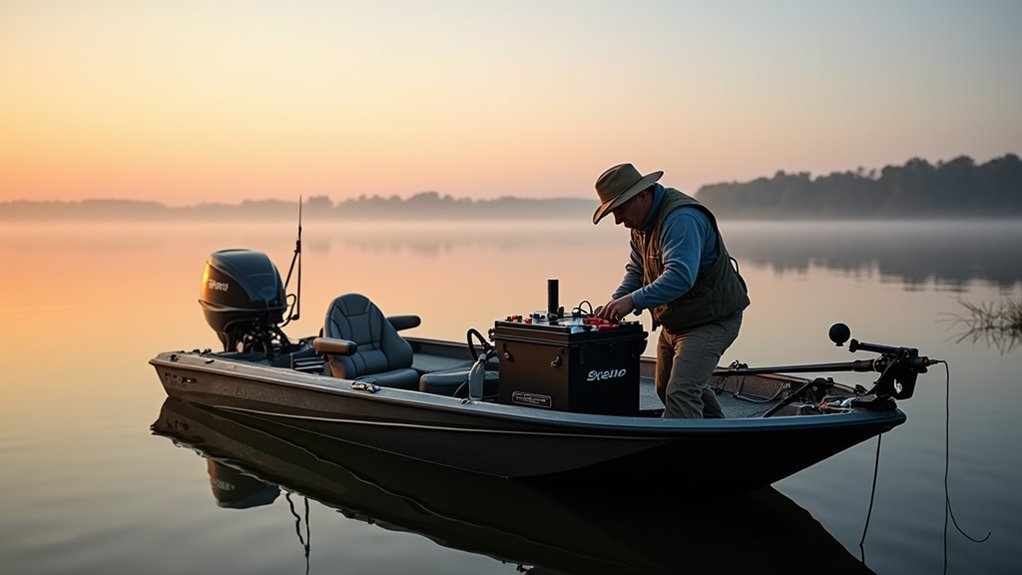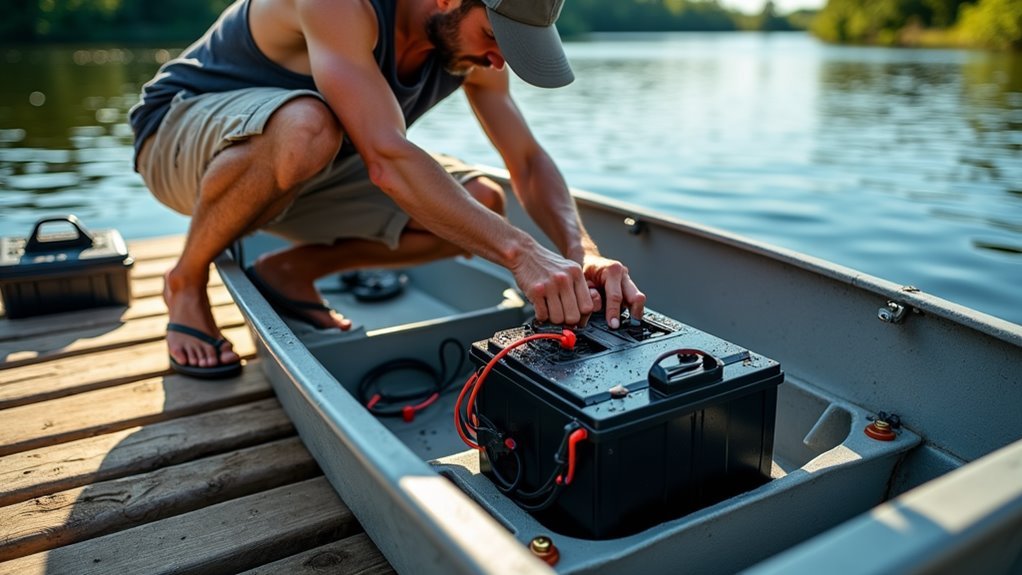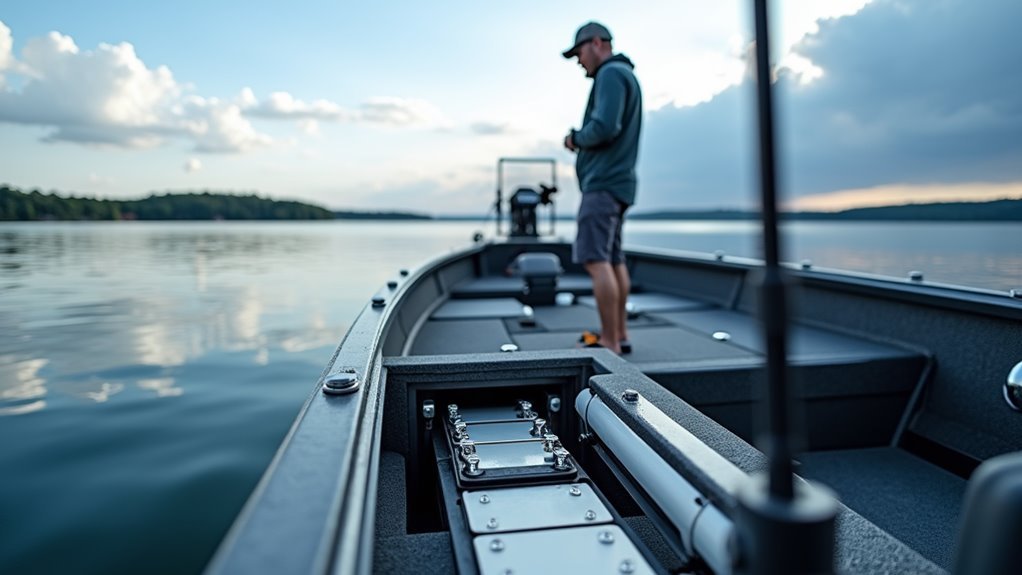We've all heard the theory that a trolling motor can make our time on the water more enjoyable and less strenuous, but isn't it equally important to identify the right battery to power it? Selecting the right battery type and managing it correctly can substantially enhance our boating experience. Should we opt for a lead-acid, AGM, or perhaps a lithium-ion battery? And how exactly do we guarantee that our battery management prevents any unfortunate hiccups during our excursions? Let's explore how we can make informed decisions that maximize our time on water.
Understanding Trolling Motor Batteries
Understanding trolling motor batteries is crucial for maximizing the performance and efficiency of your boating experience. As boating enthusiasts, we're aware of the thrill of setting sail unrestricted by limits on our adventures. Yet, behind every great journey is the functional backbone of our equipment—our trolling motor battery.
It's imperative to take into account battery weight when planning long trips. Heavier batteries usually offer more capacity, but they also weigh down our boat. We'll need to strike a balance between energy storage and portability for maximum freedom on the water.
Charging safety is another critical aspect of our battery care routine. Missteps in charging can affect not just the longevity of the battery but also our safety aboard. High voltage can stress lithium batteries, so let's resist the temptation to notch them up to full charge—contrary to what's needed for lead-acid counterparts, which thrive on being charged fully after each use. Larger batteries with higher ampere-hour ratings provide longer runtime, but they must be managed well to ensure optimal performance and safety.
Using the correct charger guarantees we're not damaging our essential power source. Charging these batteries the night before, in a cool and dry environment, helps keep them at peak performance. By understanding these details, we ensure more freedom to explore vast waterways without a hitch.
Types of Batteries Available

Exploring the options for trolling motor batteries involves a range of choices that reflect our boating needs and priorities. We can delve into several types that each bring their own strengths and considerations to the table.
Every battery type has its unique features regarding Battery Durability and Environmental Impact. By understanding these, we can make informed decisions and set sail toward more sustainable adventures.
- Lead-Acid Batteries: These traditional choices, especially Flooded Deep-Cycle and Enhanced Flooded versions, offer a cost-effective mix of deep cycling capabilities and cranking power. However, they require regular maintenance, which can affect durability over time.
- AGM Batteries: With their Absorbed Glass Mat design, these are a safer and lower-maintenance option. While they cost more upfront, their longer lifespan makes them a solid investment for heavy-duty journeys.
- Lithium-Ion (LiFePO4) Batteries: Lightweight and compact, these modern powerhouses handle deep discharges like champs and have the longest lifespan. Yet, they come with a heftier price and may not suit all trolling motors. The deep-discharge capability is particularly advantageous as it aligns with the demands of trolling motors that require consistent power over long durations.
Each battery choice carries its own implications for our adventures, but understanding these options guarantees we're both prepared and environmentally conscious.
Determining Your Power Needs

To successfully power our adventures on the water, we need to determine the right combination of batteries and motor output for our trolling motor. Let's plunge into thrust calculation and power estimation to guarantee we get it just right.
The thrust rating helps us decide how many batteries we need. For motors with 55 pounds of thrust or less, one 12V battery will suffice. If we're going for 55 to 80 pounds, we'll need two 12V batteries for a 24V setup. Higher needs demand more power: 80 pounds or more and we'll use three 12V batteries, while e-drive motors require four. Battery health and age impact its overall performance and lifespan, so maintaining a robust battery is essential to ensure longer runtimes and effective motor use.
Next, it's essential to take into account the battery capacity. A 110 amp hour battery can power our adventures for 6 to 8 hours, but lower ratings will cut that time short.
By using the runtime formula – Runtime = Battery Capacity / Motor Current Draw – we get a clear picture of how long we're set for a day of exploring.
Lastly, optimizing power consumption is pivotal. Reducing speed and smartly using our motor's variable settings can stretch those hours and give us the freedom to roam further.
Battery Installation Tips

Battery installation for trolling motors is like fitting the heartbeat into our vessel's electrical system, guaranteeing a seamless power supply.
As we set up our trolling motor's battery, the first step is understanding proper Battery Placement and Ventilation Requirements. Placing the battery in a secure, vented spot protects our gear from jolts and potential hazards.
Proper ventilation guarantees that gases escape, preventing dangerous buildups and keeping everything running safely. It's also crucial to ensure that the battery terminals are securely connected and insulated to prevent short circuits, as this reduces the risk of electrical faults.
To install with confidence, we should focus on these essentials:
- Secure Installation: Our placement decision should protect batteries from movement while allowing for secure fastening.
- Follow Manufacturer Instructions: Detailed guides from manufacturers matter; they provide essential steps tailored to our specific battery models.
- Marine-Grade Wiring: It's essential to use wires and connectors designed for marine environments to handle the conditions we face on the water.
Effective Battery Maintenance

Having securely installed our trolling motor battery with precision, we now turn our focus to effective maintenance, ensuring its longevity and reliability on the water.
The first key step is terminal cleaning. Regularly checking for corrosion and damage helps us sidestep potential issues. Let's grab a wire brush or battery scraper and gently clean those terminals if any corrosion appears. This small task can have a big impact on avoiding power interruptions during those much-needed adventures.
Our freedom-loving journey doesn't stop at the terminals. Cable inspection is equally essential. We want to catch any frayed or damaged wires early, preventing power loss and ensuring our motor is always ready to go. Consistent battery maintenance, performed every three months, is vital for keeping everything in top working condition.
Make sure the cables remain intact and tightly connected, free from any wear that could spoil the fun.
Extending Battery Life

Maximizing battery longevity guarantees our trolling motors are always ready to get us moving. By using smart charging strategies and keeping an eye on battery monitoring, we can substantially extend our battery life. Simple actions can lead to remarkable results, helping us explore without a hitch.
Recharge Practices: Always recharge the battery fully after each use so it's primed for our next outing.
Storage Conditions: Store in cool, dry places to prevent damage from extreme temperatures, ensuring the battery's health.
Corrosion Prevention: Regularly check and clean corrosion using water and baking soda for an efficient power delivery.
When it comes to battery choice, deep cycle and lithium options excel. They offer extended lifespans and reliable power, perfect for our adventure-minded lifestyle. Properly charged, these batteries keep us on the move, reducing the hassle of constant replacements.
Limiting speed shifts and managing loads effectively allows us to conserve energy, keeping our batteries in top shape. With proactive battery monitoring, we can detect issues early, adjusting our strategies to suit our needs.
In doing so, we create more freedom on the water, knowing our trolling motor's power won't fail us. Embrace these steps, and let's enjoy the waves without worry.
Frequently Asked Questions
How Do Weather Conditions Affect Trolling Motor Battery Performance?
Let's explore how weather affects battery performance. Temperature impacts efficiency, and humidity effects can reduce lifespan. Handling weather challenges wisely guarantees longer adventures. Harness nature's forces, adjust our approach, and keep our batteries in top shape for ultimate freedom
What Are the Best Practices for Winterizing Trolling Motor Batteries?
Let's guarantee maximum battery storage by fully charging and disconnecting them. Use a battery maintainer for lead-acid batteries for electrolyte maintenance. Embrace freedom with secure storage in a temperature-controlled space, avoiding restrictive temperature extremes.
Can Solar Panels Be Used to Charge Trolling Motor Batteries?
Yes, we can use solar panels to charge trolling motor batteries. Solar efficiency depends on panel size and sunlight. Larger panels charge faster, but space and power needs may challenge our freedom-loving lifestyle on the water.
How Do I Choose a Battery Charger for My Trolling Motor?
Let's choose a charger that matches our battery's voltage and type. Consider various charger types, ensuring battery compatibility. This way, we enjoy our adventures freely, with confidence our trolling motor won't leave us adrift.
What Are the Signs of a Failing Trolling Motor Battery?
When our trolling motors falter, it's vital to spot signs like voltage drops, swelling cells, and corrosion. Checking battery age, charge cycles, and maintenance helps. Let's guarantee our adventures remain unchained, free from deep discharge and inefficiency.
Conclusion
Let's set sail with confidence and smooth sailing By choosing the right battery for our trolling motor, we're stitching together a tapestry of endless water adventures. It's all about finding the perfect balance—checking our power needs, installing our battery securely, and keeping it in shipshape. With a watchful eye on maintenance and charge levels, we'll empower every adventure. So, let's gear up and plunge into the waves, knowing our journey is powered with care and smarts.